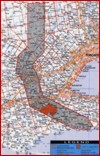|
|
![]()
|
![]()
|
![]()
|

|
![]()
|
|
Six Nations Land Claim Summaries (Basis & Allegations)
|
![]()
|
|
•
|
![]()
|
Six Nations has been researching Land Claims since the 1970's
|
![]()
|
|
•
|
![]()
|
Of the 29 submitted and potential claims, there are several more to be researched
|
![]()
|
|
•
|
![]()
|
The only claims submitted outside of the Haldimand Tract are Innisfil and East Hawkesbury Townships
|
![]()
|
|
•
|
![]()
|
Specific claims are defined as an unfulfilled Treaty or agreement between Canada and Indians.
|
|
![]()
|
|
![]()
|
![]()
|
![]()
|

|
![]()
|
The Haldimand Treaty of 1784
Whereas His Majesty having been pleased to
direct that in consideration of the early attachment
to his cause manifested by the Mohawk Indians
and of the loss of their settlement which they
thereby sustained - that a ...  View More View More
|
![]()
|
|
![]()
|
![]()
|
![]()
|
|
|
|
![]()
|
![]()
|
![]()
|
|
11. 1841 Purported General Surrender
|
![]()
|
Throughout the late 1830ís, the Six Nations regularly made complaints to the Crown regarding the squatters who were unlawfully using the unsurrendered Six Nations tract and subsequently requested action be taken for their removal.
On January 5, 1841, Samuel P. Jarvis, Superintendent General of Indian Affairs, advised by letter to John Smoke Johnson, Peter Green, Peter Fishcarrier, Thomas Echo and others forming the deputation of Mohawk Chiefs, that the Lieutenant Governor was of the opinion that the only solution to prevent unlawful white settlement on their lands was for Six Nations to surrender their lands to the Government for disposition, with the exception of portions which Six Nations wished to retain for their own use. The Lieutenant Governor recommended that Six Nations adopt this course of action and asked Six Nations to immediately choose a tract for their future residence.
Samuel P. Jarvis wrote another letter on January 15, 1841 to the Chiefs of Six Nations, as it appeared his letter of January 5, 1841 had been misinterpreted by Six Nations. Jarvis stated that by Six Nations disposing of all their lands, with the exception of those parts which they choose to occupy, their income would immediately be increased. Jarvis advised that the Government had no intention of removing any individual Indians from the lands they presently occupied; removal in all cases would be voluntary. Jarvis stated that he would not recommend nor would the Government approve the removal of upwards of 2,000 white settlers from Six Nations lands. Jarvis recommended that Six Nations approve of the Government disposing either by lease or otherwise, all their lands which could be made available, with the exception of the farms at present in their actual occupation and cultivation, and of 20,000 acres as a further reservation. The selection of the reservation was to be deferred until after a general survey of the tract when the position most advantageous to Six Nations could be more judiciously selected.
Then on January 18, 1841, a small deputation of Six Nations agreed to the proposals made by the Government per letters of January 5 and 15, 1841. This document expressly excludes the lands known as Johnson Settlement. This document is signed by Moses Walker, John S. Johnson, Skanawate, Karokarentini, John Whitecoat and Peter Green and witnessed by Jacob Martin, Jas. Winniett and John W. Gwynne. This document and the letters of January 5 and 15, 1841, were registered in the Provincial Registrar's Office on November 1, 1844.
Soon after on February 4, 1841, Six Nations petitioned the Governor General against the alleged surrender. No authority was granted by Six Nations to sign such a document and the whole procedure was rushed by Mr. Jarvis so that many of the Chiefs never even knew what was being contemplated. This petition was signed by 51 Six Nations Chiefs and Warriors.
Six Nations once again petitioned Lord Syndenham, Governor-General of British North America, on July 7, 1841 to disallow this purported surrender. The Chiefs stated that Jarvis intimidated those Indians into signing the document and that they were not Chiefs.
ALLEGATIONS
A sketch or plan was not submitted to Six Nations showing precisely what lands were at issue and in fact, none of the procedures that were required for the legal alienation of Indian lands were followed nor were they attempted to be followed.
There is no lawful surrender from Six Nations to the Crown for the sale of any portion of the lands reserved for Six Nations, nor for any portion of the lands not so reserved.
There is no Order-in-Council approving of or accepting the purported surrender and no required plan or sketch was produced then or has been produced since, which specifically identifies what, if any, lands are effected.
Promises and conditions made in the January, 1841, meetings have never been fulfilled and the Crown breached their fiduciary trust to the Six Nations.
**These are brief summaries and they are subject to change as additional research information may be acquired
|
|

